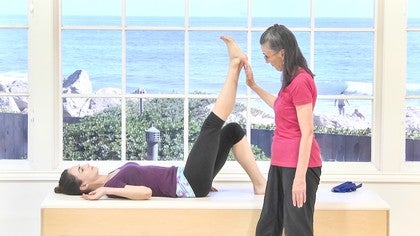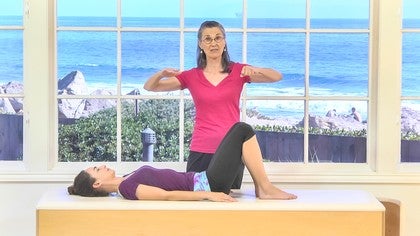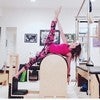Description
About This Video
Transcript
Read Full Transcript
My name, Deborah Colway. I live in boulder, Colorado and I had the amazing good fortune to apprentice with Eve gentry in 1989 and 90 primarily a when I worked with eve, uh, she was working with a lot of people who had chronic pain and that was a lot of what she taught me how to deal with that. Uh, I'm going to show you a small series of movements in the style that she would have worked with somebody, um, helping them to release the chronic bracing that comes when we have pain. You'd call it joint release work. She known for that and it's a beautiful series and I hope you enjoy it. You're going to just go ahead and lie down and relax. Straighten your legs, I think is a good idea because I'm gonna be standing above you. Okay. So it's called the pole work, for lack of a better, better term.
And really one of the hallmarks of Eve's work was that if you had, and if you have an area of pain, she doesn't just go give you exercises for that area. There was a very beautiful way of working such that she felt very strongly that of course you have to restore movement to an area. But typically what's happening if you have pain is you don't want to move that area. You're holding your bracing. And then of course, lack of circulation just makes the whole thing get worse and it becomes a habit. So my job, okay, is to actually help you restore movement, but without you having to exert any muscular effort to make it happen. So you get to just completely relax. And that's not so easy. Huh?
Because if you're used to bracing and holding, you're going to resist against me a little bit. Yeah. So we've worked together, you know, you would, you know, you have to gain trust. Okay. So we would've, I wouldn't start day one standing above you with his pole. Okay. So I'm going to protect myself by a little bend in my knees using my abdominals tooth, but on her, my back. And then I'm just gonna ask you as best you possibly can. She has, let me take the weight of your arm. Yeah. Okay. So the first thing I do is I'm going to gently pull up on you.
You're going to breathe in and let your head just hang back and then exhale. And I am feeling for that moment where the back of you rests back down onto the mat. So nope, just breathe in and out. Good an n and hang and out feeling fine. Okay, let's do two more. I'm lifting and opening. You're hanging, releasing the neck and head. Exhale. And one more time. Inhale and ex. Yeah. Okay.
So now I'm going to do this little sculling sculling action. Okay. So you still want to hang as I take the bar down, just bend your elbows and you hear that Plop, you're kind of going for the plop. Oh, right. So I'm doing the movement, I'm holding the pole, I'm directing the pole. You're just holding onto the pole and that's it. And then let's say I wanted to begin to teach you to encourage you to take on this movement, right?
So what I have you consider is that it's, even if I'm not moving the pole, it's the pole is still moving you. So you can think about the tips of the pole. So then I'm going to say, when you're ready, you take it. Oh, don't hit your face. That's it. And I back away a little bit and you just keep feeling like the movement is moving you. The pole is moving. You still going for the block, still going for the block.
And there's this suspension and suspension release. Suspension. Release. Suspension. Release, right? Yeah. So then we're going to go the other way. There we go. Now I'm doing it again. I'm holding the pole. I'm holding a little bit of you. The pole is moving you. I'm moving you.
And then when you're ready to take it over, I don't just drop you right? I feel you in there. Go for the PLOP. That's it. Think tips of pole. There you go. You Ready? There you go. Don't hit yourself. That's it. And you could make it bigger if you wanted to, but it's the tips of the pole, the tips of the pole. Okay.
And I'm going to take it, and then we're going to do this little figure eight thing, which is why I need to be up on top of the Cadillac. So I hit the floor. Now you can see or feel how much you're moving. Right? And you have a frozen shoulder, right? Or you know, somebody who has that and thinks, I mean look at this gorgeous movement through your chest, through your rib cage, with your breath, your neck, right? So again, I would say let's go the other way and I kinda wanna um, fake you out a little bit. Yeah, catch you a little bit off guard. Not to freak you out, but to, um, Kinda cut through your habit of bracing.
And you know, you have to admit you're getting a lot of Nice movement in your body, aren't you? Absolutely. So now if you want, you can take it over. Tips of polls, tips and polls, tips of polls, figure eights, tips of Paul's. There you go. And then don't think too hard. Go the other way. Yeah, yeah. Okay. So I'll get you going again. There we go. Because you've spent, I don't know how many years, thinking hard because it hurts. So you've had to protect yourself.
It hurts to think hard to hurts to think hard to, that's it. But wouldn't it be fabulous if we could get some movement and circulation back into those areas? Clear some of that debris out. And not only that, but make you realize that you're not as blocked as you think. But we're not, I'm not talking to your shoulder. Am I not talking to your neck? Am I talking to the tips of the pole steps of the pole. Okay. Ready? Okay. Yeah, go to the polls and when you're ready to go the other way.
Ooh. Yay. Don't hit your head. There you go. That's it. Beautiful. So come back up to the top. Ah, and just rest. And then there's one last part, which feels good, which is that it's very random. Again, it's a little bit like surprising you not scaring you. Okay. She would take the tip and she would pull you over here. Then she would take the tip and she would pull you over. That's again, why you gotta be up on top of the Cadillac. Don't let it go the pole. Well, we're here. Maybe you haven't taken your arms over head for a long time, you know, just whatever it is, not doing the same pattern every time so that you learn it and then learn to hold on. Right. There we go. Things like that. And then let's just do one more. Hang. Okay. Ah, so yeah, take a breath and then as you exhale this time and suspend there.
Inhale. Exhale. So that goes along with the, the releasing breath for eve. Right. Inhale, exhale, exhale. Feel the exhale. Soften. Relax. Like go. Breathe in. Axial. Good. Now I'm going to take the pole away. You keep your arms up and when you're ready, just drop them. Yeah, yeah.
I definitely was trying to control it. [inaudible]
Everything gets all dried out and brittle. Right. So the first thing is to bring movement back to the area. But your habit is to brace when you move because you're afraid it's going to hurt. Yeah. So my job is to hold the part for you to move. You gained some alliance, some trust, you know, so that you let me, so that doesn't happen right away.
You have to work together a little bit. So then I hold your limb and take you through some kind of range of motion, your giving me your weight. And after why, you have to realize, oh wait a second, that thing is moving. So then the next way is how the next bit would be. How do I get you to take it over? But not entirely. So in this instance I'm holding the pole. This is one of the more vigorous ones, right? So I'm holding the pole.
The Pole is moving you and I have to get you to think, okay. Because a lot of times what happens is people will just, they'll start to do this, but you have to stay with the imagery and the thought that the tips of the pole and it's the periphery. You see, you're not going in here trying to make your shoulder move. You're out here where it's light and airy and you're getting the movement to kind of come in all around it. The little sneaky, you know? So then so, so I support your body and I do the movement. Then we give you some kind of a prop if it's near folds.
And every time you lift your leg, you know you freeze up your back. So then I do it. Then you take your pants, your bicep, and your pants, then eventually you do it. So it'll be the same thing. Eventually, you know, you'd have nothing and you would start to do something with your arms and then, and then the next phase would be to give you some kind of resistance so that you could actually build strength. And that's joint release. The first part. Yeah. Fantastic. Has to move first before it can strengthen. Sure. If you just try and strengthen over top of a freezing or a bracing, you just going to embed that braced habit and pattern into the body even more.
Thank you very much.
Pilates Legacy Project - Playlist 8: Eve Gentry Methods
Comments

You need to be a subscriber to post a comment.
Please Log In or Create an Account to start your free trial.

























